|
|
Fiscal Year 2004–2005: 1
- Table of Contents - Next -
Fiscal Year 2005–2006
The Government of Canada posted a budgetary surplus of $13.2 billion in 2005–06. The surplus reflects strong revenue growth and effective management of spending by the Government. Taking all levels of government together, the Organisation for Economic Co-operation and Development (OECD) estimates that Canada was the only Group of Seven (G7) country to post a surplus in 2005.
A core priority of the Government is to improve the accountability and transparency of government operations to Canadians. This includes the financial reporting on those operations. Full and clear information on programs and operations allows citizens and Parliament to hold the Government accountable for its actions and results. To this end, the Government has taken a number of steps to improve the transparency of its financial reporting in 2005–06, including moving the presentation of revenues and expenses in the Annual Financial Report of the Government of Canada from a net to a gross basis, incorporating the results of certain foundations within the Government’s financial statements, and publishing quarterly updates of the Government’s fiscal forecast for the current year.
The Government is committed to managing overall spending to ensure that government programs focus on results and value for money, and are consistent with government priorities and responsibilities. The 2005–06 surplus was $5.2 billion higher than forecast in the May 2006 budget due largely to lower than planned program expenses. Program expenses fell by 0.7 per cent in 2005–06, marking the first decline in nine years.
Federal debt as a percentage of gross domestic product (GDP) was 35.1 per cent in 2005–06, down 33.3 percentage points from its peak of 68.4 per cent in 1995–96. It is now at its lowest level in 24 years. Canada’s net debt burden is the lowest in the G7.
In the 2006 budget, the Government set an objective of reducing the federal debt-to-GDP ratio to 25 per cent by 2013–14. The results for 2005–06 indicate that it is well placed to achieve that objective.
The financial data in this report are based on the audited results, which will appear in more detail in the 2006 Public Accounts of Canada, scheduled for tabling in the House of Commons later this fall. They cover the federal government’s spending and revenue performance for the past fiscal year (April 1, 2005 to March 31, 2006) and detail the factors affecting these results. In addition, the Fiscal Reference Tables publication has been updated to incorporate the results for 2005–06. These tables are an integral part of this report.
The Honourable James M. Flaherty, P.C., M.P.
Minister of Finance
Note to Readers
As announced in the May 2006 budget, revenues and expenses reported in the Annual Financial Report of the Government of Canada are now presented on a gross basis. Previously, they were presented on a net basis, whereby certain disbursements were netted against budgetary revenues and certain revenues were netted against expenses. The move to the gross basis brings the presentation of revenues and expenses in the Annual Financial Report in line with the presentation of annual audited results reported in the Public Accounts of Canada.
There are three major components that are affected by the move to the gross basis of presentation:
- The Canada Child Tax Benefit is now accounted for as an expense, whereas previously it was netted against personal income tax revenues.
- Departmental revenues that are levied for specific services, such as the contract costs of policing services in provinces, are now included in revenues, whereas previously these were netted against expenses.
- Revenues of consolidated Crown corporations are now included in revenues, whereas previously these were netted against their total expenses.
This change in presentation increases both budgetary revenues and expenses by the same amount and has no impact on the budgetary balance.
During 2005–06, the Government retroactively adopted the new recommendations of the Public Sector Accounting Board of the Canadian Institute of Chartered Accountants regarding the government reporting entity. The new standard expanded the definition of control. As a consequence, some organizations that were previously not part of the Government’s reporting entity are now included in the Government’s financial statements through consolidation. These organizations include:
- Canada Foundation for Innovation.
- Canada Millennium Scholarship Foundation.
- Sustainable Development Technology Canada.
- Aboriginal Healing Foundation.
- St. Lawrence Seaway Management Corporation.
This change resulted in a restatement of prior years’ results and federal debt.
The Government reports all revenues and expenses on an accrual basis. Further details on the Government’s accounting policies can be found in the section entitled "Notes to the Condensed Financial Statements of the Government of Canada" and in the 2006 Public Accounts of Canada.
The Fiscal Reference Tables have been revised to reflect the changes mentioned above as well as historical revisions to the National Economic and Financial Accounts published by Statistics Canada.
Report Highlights
|
The Budgetary Balance
A budgetary surplus of $13.2 billion was recorded in 2005–06. Budgetary revenues increased by $10.3 billion, or 4.8 per cent, over 2004–05, reflecting strong growth in the economy and the applicable tax bases. Public debt charges declined by $0.3 billion, or 1.0 per cent, due to a decline in the stock of interest-bearing debt. Program expenses decreased by $1.1 billion, or 0.7 per cent, due to a number of one-time expenses which boosted spending in 2004–05, as well as developments in 2005–06 which reduced spending, most notably the dissolution of Parliament in November 2005 and the change in government. This marks the first year-over-year decrease in federal program expenses in nine years.
To enhance the comparability of financial results over time and across jurisdictions, the budgetary balance and its components are often presented as a percentage of GDP.
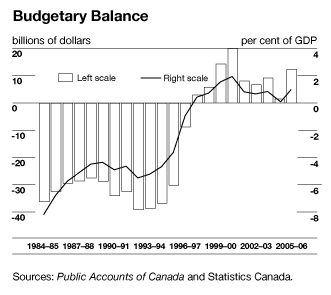
The budgetary surplus as a percentage of GDP increased from 0.1 per cent in 2004–05 to 1.0 per cent in 2005–06. The fiscal improvement is attributable to a decline in the program expense to GDP ratio, which fell from 13.7 per cent to 12.8 per cent (Table 1). Public debt charges as a percentage of GDP fell from 2.6 per cent in 2004–05 to 2.5 per cent in 2005–06.
Table 1
Budgetary Revenues and Expenses
|
|
|||
| 2004–05 | 2005–06 | Change1 | |
|---|---|---|---|
|
|
|||
| ( per cent of GDP) | |||
| Budgetary revenues | 16.4 | 16.2 | -0.2 |
| Program expenses | 13.7 | 12.8 | 0.9 |
| Public debt charges | 2.6 | 2.5 | 0.2 |
| Budgetary balance | 0.1 | 1.0 | 0.9 |
|
|
|||
| 1 A negative number indicates a
deterioration in the balance. A positive number indicates an improvement
in the balance. Note: Numbers may not add due to rounding. |
|||
The change in program expenses as a percentage of GDP was due to a number of one-time expenses recorded in 2004–05, as well as the dissolution of Parliament in November 2005 and the change in government. The decline in public debt charges as a percentage of GDP was attributable to a decline in interest-bearing debt.

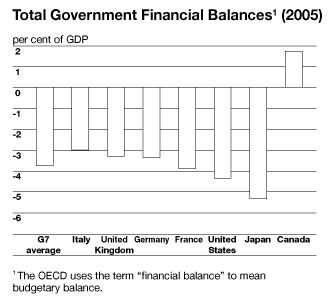
Budgetary revenues as a percentage of GDP fell from 16.4 per cent in 2004–05 to 16.2 per cent in 2005–06, reflecting $5.0 billion in personal income tax reductions that came into effect in 2005–06.
In 2005–06, the provinces and territories continued to improve their fiscal situation due to strong revenue growth, particularly from natural resource royalties and personal and corporate income taxes. The aggregate provincial-territorial surplus is currently estimated at $13.2 billion[1] for 2005–06, up from the $6.5-billion aggregate surplus posted in 2004–05.
As a result of improving budgetary balances and economic growth in recent years, both federal and provincial-territorial debts have declined as a share of GDP, with the federal debt ratio falling more dramatically. However, federal debt as a share of GDP still exceeds that of most provinces and remains significantly higher than the provincial average. Lower debt-to-GDP ratios, combined with lower interest rates and improved credit ratings, have enabled both orders of government to allocate a smaller portion of revenues to debt interest payments and a greater portion to program expenditures, tax reductions and debt repayment.
According to Organisation for Economic Co-operation and Development (OECD) estimates for the total government sector,[2] Canada was the only Group of Seven (G7) country to record a surplus in calendar year 2005. Canada’s surplus for 2005 is estimated at 1.7 per cent of GDP, compared to an average deficit of 3.7 per cent in the G7 countries. Moreover, Canada is expected to continue to be the only G7 country to post a total government surplus again in 2006 and 2007.
Federal Debt
The 2005–06 surplus of $13.2 billion brings federal debt—the accumulation of annual deficits and surpluses since Confederation—down to $481.5 billion. Federal debt has declined by $81.4 billion from its peak of $562.9 billion in 1996–97. As a share of GDP, it dropped to 35.1 per cent in 2005–06, down from the peak of 68.4 per cent in 1995–96, bringing it to its lowest level since 1981–82. Federal debt at the end of 2005–06 was $14,815 for each Canadian, down from $15,376 a year earlier.
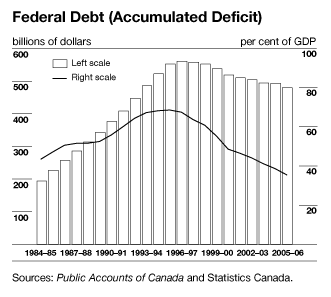
| Federal Debt (Accumulated Deficit)
Since 2002–03, the financial statements of the Government of Canada are presented on a full accrual basis of accounting. Under the previous accounting standard—modified accrual accounting—net debt and the accumulated deficit were identical. Under the new standard, net debt now includes a comprehensive costing for financial liabilities but excludes non-financial assets. The accumulated deficit includes both. It is the sum of all surpluses and deficits in the past. Federal debt, referred to in the budget documents and the Annual Financial Report of the Government of Canada, is the accumulated deficit. It is the federal government’s main measure of debt, as annual changes in this measure correspond to the budgetary balance. |
Table 2
Financial Highlights
|
|
||
| 2004–05 | 2005-06 | |
|---|---|---|
|
|
||
| ($ billions) | ||
| Budgetary transactions | ||
| Revenues | 211.9 | 222.2 |
| Expenses | ||
| Program expenses | -176.4 | -175.2 |
| Public debt charges | - 34.1 | -33.8 |
|
|
||
| Total expenses | -210.5 | -209.0 |
| Budgetary balance | 1.5 | 13.2 |
| Non-budgetary transactions | 5.1 | -6.4 |
| Financial source/requirement | 6.6 | 6.8 |
| Net change in financing activities | -6.6 | -6.3 |
|
|
||
| Net change in cash balances | 0.0 | 0.5 |
| Cash balance at end of period | 20.6 | 21.1 |
| Financial position | ||
| Total liabilities | 705.0 | 702.5 |
| Total financial assets | 155.4 | 165.6 |
|
|
||
| Net debt | 549.6 | 536.9 |
| Non-financial assets | 54.9 | 55.4 |
|
|
||
| Federal debt (accumulated deficit) | 494.7 | 481.5 |
| Financial results (% of GDP) | ||
| Budgetary revenues | 16.4 | 16.2 |
| Program expenses | 13.7 | 12.8 |
| Public debt charges | 2.6 | 2.5 |
| Budgetary balance | 0.1 | 1.0 |
| Federal debt (accumulated deficit) | 38.3 | 35.1 |
|
|
||
| Note: Numbers may not add due to rounding. | ||
Financial Source/Requirement
The financial source/requirement measures the difference between cash coming in to the Government and cash going out. There was a financial source of $6.8 billion in 2005–06, compared to a financial source of $6.6 billion in 2004–05.
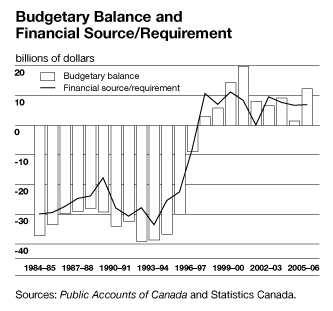
Budgetary Revenues
Budgetary revenues were $222.2 billion in 2005–06, an increase of $10.3 billion, or 4.8 per cent, from 2004–05 (Table 3). Tax revenues rose by $11.2 billion, or 6.4 per cent, while employment insurance (EI) premium revenues fell by $0.8 billion, or 4.5 per cent. Other revenues decreased by $0.2 billion, or 0.9 per cent. Total budgetary revenues were $1.3 billion, or 0.6 per cent, higher than estimated in the May 2006 budget. Excluding the impact of a change in the Government’s accounting treatment of subscriptions in the International Monetary Fund (IMF), revenues increased by $0.3 billion over the Budget 2006 estimate.
Table 3
Revenues
|
|
||||
| 2004–05 | 2005–06 | Net change | ||
|---|---|---|---|---|
|
|
||||
| ($ millions) | (%) | |||
| Tax revenues | ||||
| Income tax | ||||
| Personal income tax | 98,521 | 103,691 | 5,170 | 5.2 |
| Corporate income tax | 29,956 | 31,724 | 1,768 | 5.9 |
| Other income tax | 3,560 | 4,529 | 969 | 27.2 |
|
|
||||
| Total | 132,037 | 139,944 | 7,907 | 6.0 |
| Other taxes and duties | ||||
| Goods and services tax | 29,758 | 33,020 | 3,262 | 11.0 |
| Energy taxes | 5,054 | 5,076 | 22 | 0.4 |
| Customs import duties | 3,091 | 3,330 | 239 | 7.7 |
| Air Travellers Security Charge | 383 | 353 | -30 | -7.8 |
| Other excise taxes and duties | 4,571 | 4,377 | -194 | -4.2 |
|
|
||||
| Total | 42,857 | 46,156 | 3,299 | 7.7 |
| Total tax revenues | 174,894 | 186,100 | 11,206 | 6.4 |
| Employment insurance premium revenues |
17,307 | 16,535 | -772 | -4.5 |
| Other revenues | ||||
| Crown corporation revenues | 6,825 | 7,198 | 373 | 5.5 |
| Foreign exchange revenues | 1,175 | 2,014 | 839 | 71.4 |
| Other program revenues | 11,742 | 10,356 | -1,386 | -11.8 |
|
|
||||
| Total | 19,742 | 19,568 | -174 | -0.9 |
| Total revenues | 211,943 | 222,203 | 10,260 | 4.8 |
|
|
||||
| Note: Numbers may not add due to rounding. | ||||
The largest source of budgetary revenues in 2005–06 was personal income tax revenues, which stood at 46.7 per cent of budgetary revenues. The second largest source was goods and services tax (GST) revenues, at 14.9 per cent. Corporate income tax revenues were 14.3 per cent of budgetary revenues, up 8.6 percentage points from a low of 5.7 per cent in 1992–93. EI premium revenues contributed to 7.4 per cent of revenues.
Personal income tax revenues increased by $5.2 billion, or 5.2 per cent, in 2005–06. Taking into account the $5.0 billion in tax reduction measures pertaining to 2005–06, the underlying growth in personal income tax revenues was over 10 per cent, well above the 5.8-per-cent increase in personal income in the same period. The difference in growth rates reflects a number of factors, including the interaction of strong real income gains with the progressivity of the personal income tax system and the fact that personal income, as measured in the National Income and Expenditure Accounts, excludes some components of taxable income, such as pension income and capital gains.

Corporate income tax revenues were $1.8 billion, or 5.9 per cent, higher in 2005–06 than in 2004–05. This gain was lower than the 10.6-per-cent growth in corporate profits in 2005, reflecting in part the ongoing implementation of tax measures. Other income tax revenues—largely withholding taxes levied on non-residents—were $1.0 billion, or 27.2 per cent, higher in 2005–06 than in the previous year, reflecting strong growth in dividend payments to non-residents recorded in the latter months of 2005.
Other taxes and duties increased by $3.3 billion, or 7.7 per cent, in 2005–06,
primarily due to higher GST revenues, which were up $3.3 billion, or 11.0 per cent. Growth in GST revenues was significantly higher than growth in the
applicable tax base. In recent years, there has been substantial variation
between growth in GST revenues and growth in the underlying tax base, with GST
revenue growth exceeding growth in the tax base in some years, as in 2005–06,
and falling short of growth in the tax base in other years.
The $0.2-billion, or
4.2-per-cent, decline in other excise taxes and duties principally reflects
declining revenues from tobacco duties.
EI premium revenues declined by $0.8 billion, or 4.5 per cent, from the previous year, reflecting reductions in premium rates, which more than offset the impact of higher employment and wages and salaries. The decline also reflects the implementation of the Quebec Parental Insurance Plan in January 2006, under which the responsibility for delivering parental benefits in Quebec, along with collection of the associated premium revenues, was transferred to the Province of Quebec.
Other revenues consist of revenues from Crown corporations, such as the Bank of Canada, Export Development Canada and Canada Mortgage and Housing Corporation; foreign exchange revenues; and other program revenues, primarily revenues from the sales of goods and services. Other revenues were down $0.2 billion, or 0.9 per cent, in 2005–06. After adjusting for the one-time $2.6-billion gain the Government realized by selling its remaining shares in Petro-Canada in 2004–05, other revenues rose by $2.4 billion in 2005–06. Of the $2.4-billion increase in other revenues, $1.0 billion relates to a one-time adjustment recorded in 2005–06 resulting from a change in the Government’s accounting treatment of Canada’s subscriptions in the IMF. This change was made during the year-end process of preparing the financial statements, and after discussions with the Auditor General, to reflect the impact of currency fluctuations in a more timely manner. The remaining increase in other revenues reflects growth in Crown corporation revenues and other program revenues, including sales of goods and services and return on investments.
The revenue ratio—budgetary revenues as a percentage of GDP—represents an approximate measure of the overall federal tax burden in that it compares the total of all federal revenues to the size of the economy. The revenue ratio stood at 16.2 per cent in 2005–06, down from 16.4 per cent in 2004–05. This decline was primarily due to tax reduction measures in 2005, including a drop in the lowest personal income tax rate, an increase in the basic personal amount and a reduction in the federal capital tax rate.
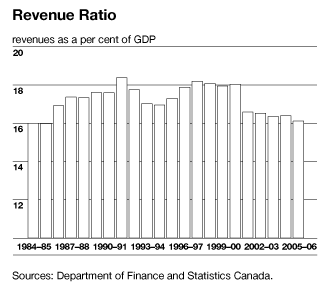
Total Expenses
Total expenses consist of program expenses and public debt charges. In 2005–06 total expenses amounted to $209.0 billion, down $1.5 billion, or 0.7 per cent, from 2004–05.
Major transfers to persons (elderly benefits, EI benefits and the Canada Child Tax Benefit) and major transfers to other levels of government (the Canada Health Transfer, the Canada Social Transfer, fiscal arrangements and Alternative Payments for Standing Programs) are the two largest components of total expenses, representing 25.2 and 19.5 per cent of expenses, respectively. Other transfers made by various federal departments to individuals, businesses and other organizations and groups made up 11.9 per cent of total expenses in 2005–06.
After transfers, the next largest component of total expenses was operating costs of government departments and agencies, excluding National Defence, at 16.6 per cent. Operating costs include items such as salaries and benefits, facilities and equipment, and supplies and travel.
Public debt charges amounted to 16.2 per cent of total expenses in 2005–06. This is down from a peak of nearly 30 per cent in the mid-1990s, when it was the largest component of expenses, reflecting the large stock of interest-bearing debt and high average effective interest rates on that stock. With the reductions in interest-bearing debt and lower interest rates, its share of total expenses has fallen over 13 percentage points from a high of 29.8 per cent in 1996–97.
Program expenses amounted to $175.2 billion in 2005–06, a decrease of $1.1 billion, or 0.7 per cent, from 2004–05 (Table 4). This marks the first year-over-year decline in nine years. The decrease was due to a number of one-time expenses recorded in 2004–05 as well as developments in 2005–06, most notably the dissolution of Parliament in November 2005 and the change in government.
Table 4
Total Expenses
|
|
||||
| 2004–05 | 2005–06 | Net change | ||
|---|---|---|---|---|
|
|
||||
| ($ millions) | (%) | |||
| Transfers payments | ||||
| Major transfers to persons | ||||
| Elderly benefits | 27,871 | 28,992 | 1,121 | 4.0 |
| Employment insurance benefits | 14,748 | 14,417 | -331 | -2.2 |
| Canada Child Tax Benefit/ | 8,688 | 9,200 | 512 | 5.9 |
|
|
||||
| Total | 51,307 | 52,609 | 1,302 | 2.5 |
| Major transfers to other levels of government |
||||
| Support for health and
other social programs |
23,081 | 27,225 | 4,144 | 18.0 |
| Wait Times Reduction Fund | 4,250 | -4,250 | ||
| Medical Equipment Fund | 500 | -500 | ||
| Early learning and child care | 700 | -700 | ||
| Bill C-48 | 3,300 | 3,300 | ||
| Fiscal arrangements and other transfers | 13,340 | 13,021 | -319 | -2.4 |
| Offshore Revenues Accords | 2,830 | -2,830 | ||
| Alternative Payments
for Standing Programs |
-2,746 | -2,731 | 15 | -0.5 |
|
|
||||
| Total | 41,955 | 40,815 | -1,140 | -2.7 |
| Direct program expenses | ||||
| Subsidies and other transfers1 | 25,453 | 24,893 | -560 | -2.2 |
| Other program expenses | ||||
| Crown corporations | ||||
| Canada Mortgage and
Housing Corporation |
2,072 | 2,119 | 48 | 2.3 |
| Canadian Broadcasting Corporation | 1,714 | 1,705 | -9 | -0.5 |
| Other cultural agencies | 700 | 668 | -31 | -4.5 |
| Canadian Air Transport
Security Authority |
295 | 349 | 54 | 18.3 |
| Other | 4,127 | 2,354 | -1,773 | -43.0 |
|
|
||||
| Total | 8,907 | 7,195 | -1,712 | -19.2 |
| National Defence | 14,318 | 15,034 | 716 | 5.0 |
| All other departments and agencies | 34,422 | 34,667 | 245 | 0.7 |
|
|
||||
| Total other program expenses | 57,647 | 56,896 | -751 | -1.3 |
| Total direct program expenses | 83,100 | 81,789 | -1,311 | -1.6 |
| Total program expenses | 176,362 | 175,213 | -1,149 | -0.7 |
| Public debt charges | 34,118 | 33,772 | -346 | -1.0 |
| Total expenses | 210,480 | 208,985 | -1,495 | -0.7 |
|
|
||||
| 1 See Table 5 for details. Note: Numbers may not add due to rounding. |
||||
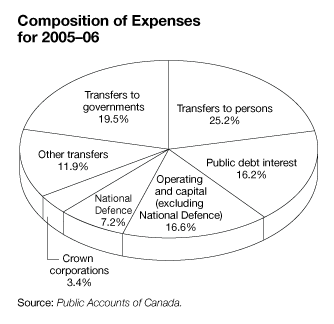
Within program expenses, transfer payments decreased by $0.4 billion, while Crown corporation expenses decreased by $1.7 billion. These decreases were partially offset by a modest increase in the operating expenses of National Defence and other departments and agencies.
Public debt charges declined by $0.3 billion, or 1.0 per cent.
Major transfers to persons increased by $1.3 billion, or 2.5 per cent.
- Elderly benefits consist of Old Age Security, Guaranteed Income Supplement and Allowance payments. Total benefits were up $1.1 billion, or 4.0 per cent, in 2005–06, reflecting both higher average benefits, which are indexed to inflation, and an increase in the number of recipients.
- EI benefits consist of regular benefits, special benefits (sickness,
maternity, parental, adoption and fishing) and labour market adjustment
benefits. Total benefits decreased by $0.3 billion in
2005–06 due to a decline in regular benefits, in line with improvements in the labour market.
- The Canada Child Tax Benefit consists of the base benefit, the National Child Benefit (NCB) supplement and the Child Disability Benefit. These benefits increased by 5.9 per cent in 2005–06, from $8.7 billion in 2004–05 to $9.2 billion in 2005–06, primarily due to an increase in the NCB supplement in July 2005.
Major transfers to other levels of government include the Canada Health Transfer (CHT), the Canada Social Transfer (CST), fiscal arrangements (equalization, transfers to the territories, as well as a number of smaller transfer programs), and Alternative Payments for Standing Programs. Transfers decreased by $1.1 billion, or 2.7 per cent, in 2005–06, following an increase of $12.6 billion, or 42.7 per cent, in 2004–05. The decline in 2005–06 reflects a number of one-time transfers to the provinces and territories in 2004–05, including $4.3 billion for the Wait Times Reduction Fund, $2.8 billion for the Offshore Revenues Accords, $700 million for early learning and child care and $500 million for medical equipment.
- The CHT and CST—block-funded transfers—support health care, post-secondary education, social assistance and social services, including early childhood development. They provide support in the form of cash and tax transfers to the provinces and territories. These transfers in support of health and other social programs increased by $4.1 billion in 2005–06, reflecting legislated increases in the CHT and the CST in 2005–06.
- Total entitlements under fiscal arrangements and other transfers decreased by $0.3 billion to $13.0 billion in 2005–06.
- Bill C-48, An Act to authorize the Minister of Finance to make certain payments, authorizes the Minister of Finance to make payments for specified purposes, totalling no more than $4.5 billion, from any surplus above $2 billion in 2005–06 and/or 2006–07. The Government expensed $3.3 billion in transfers to provinces and territories for post-secondary education, public transit and affordable housing under this authority in 2005–06. An additional $320 million in foreign assistance was expensed under Bill C-48 in 2005–06 and is included in subsidies and other transfers.
- Alternative Payments for Standing Programs represent recoveries of federal tax point abatements under contracting-out arrangements. These arrangements allow provinces to assume the administrative and financial authority for certain federal-provincial programs. In turn, the federal government provides provinces with tax points, the value of which are netted against total entitlements and accordingly recovered from cash transfers. These recoveries reflect the growth in the value of the tax points.
Subsidies and other transfers decreased by $0.6 billion, or 2.2 per cent, in 2005–06, reflecting fairly broad-based declines across departments (Table 5).
Table 5
Subsidies and Other Transfers
|
|
||||
| 2004–05 | 2005–06 | Net change | ||
|---|---|---|---|---|
|
|
||||
| ($ millions) | (%) | |||
| Agriculture and Agri-Food | ||||
| BSE recovery program | 1,488 | 33 | -1,455 | -97.8 |
| Grains and Oilseeds Payment Program | 0 | 756 | 756 | |
| Other | 1,264 | 1,806 | 542 | 42.9 |
|
|
||||
| Total | 2,752 | 2,595 | -157 | -5.7 |
| Foreign Affairs and International Trade | 3,408 | 3,357 | -51 | -1.5 |
| Health Canada | ||||
| First Nations and Inuit health | 779 | 857 | 77 | 9.9 |
| Canadian Institutes of Health Research | 705 | 758 | 53 | 7.6 |
| Primary Health Care Transition Fund | 211 | 185 | -26 | -12.3 |
| Other | 381 | 281 | -101 | -26.4 |
|
|
||||
| Total | 2,076 | 2,080 | 4 | 0.2 |
| Human Resources and Skills Development | ||||
| Student assistance programs | 759 | 848 | 89 | 11.8 |
| Labour market programs | 500 | 526 | 26 | 5.2 |
| Energy Cost Benefit | 0 | 210 | 210 | |
| Other | 358 | 609 | 251 | 70.2 |
|
|
||||
| Total | 1,616 | 2,193 | 577 | 35.7 |
| Indian and Northern Affairs | 4,934 | 5,401 | 468 | 9.5 |
| Industry/regional agencies/granting councils | ||||
| Technology Partnerships Canada | 304 | 284 | -20 | -6.6 |
| Infrastructure Canada | 398 | 368 | -30 | -7.5 |
| Regional agencies | 563 | 537 | -26 | -4.5 |
| Natural Sciences and Engineering Research Council of Canada/ Social Sciences and Humanities Research Council of Canada |
1,263 | 1,371 | 107 | 8.5 |
| Other | 377 | 434 | 56 | 15.0 |
|
|
||||
| Total | 2,905 | 2,994 | 88 | 3.0 |
| Genome Canada | 225 | 0 | -225 | -100.0 |
| Green Municipal Fund | 300 | 0 | -300 | -100.0 |
| Other | 7,236 | 6,272 | -964 | -13.3 |
|
|
||||
| Total | 25,453 | 24,893 | -560 | -2.2 |
|
|
||||
| Note: Numbers may not add due to rounding. | ||||
Other program expenses—total program expenses less transfers—consist of the operating costs of government: the more than 130 departments, agencies, Crown corporations and other federal bodies that deliver programs and services to Canadians. These expenses amounted to $56.9 billion in 2005–06, down $0.8 billion, or 1.3 per cent, from 2004–05. Within this component:
- Crown corporation expenses fell $1.7 billion to $7.2 billion in 2005–06, mainly due to a one-time $2.3-billion expense recorded by Atomic Energy of Canada Limited for environmental liabilities in 2004–05.
- Defence expenses increased by $0.7 billion, or 5.0 per cent, primarily reflecting incremental annual resources to strengthen Canada’s military.
- All other departmental and agency expenses increased by $0.2 billion, or 0.7 per cent, due to growth in operating costs.
Public debt charges declined by $0.3 billion, or 1.0 per cent, to $33.8 billion in 2005–06, reflecting the impact of a decline in the stock of interest-bearing debt.
- The average effective interest rate on the Government’s
interest-bearing debt (unmatured debt and pension and other accounts) was 5.6 per cent in 2005–06, unchanged from 2004–05. The average effective interest rate was 5.0 per cent on unmatured debt (5.0 per cent in 2004–05); in contrast, the average effective
interest rate on pension and other accounts was 6.9 per cent
(6.9 per cent in 2004–05).
- The stock of total interest-bearing debt decreased by $6.2 billion, from $607.2 billion in 2004–05 to $601.1 billion in 2005–06. The stock of unmatured debt declined by $6.3 billion to $421.1 billion, while liabilities for pension and other accounts increased by $0.1 billion to $179.9 billion.
The interest ratio—public debt charges as a percentage of budgetary
revenues—declined from 16.1 per cent in 2004–05 to 15.2 per cent in
2005–06.
This ratio means that, in 2005–06, the Government spent just over 15 cents of
every revenue dollar on interest on the public debt. This is down from the peak
of about 38 cents in 1990–91 and is the lowest this ratio has been since the
late 1970s. This is money that must be paid to meet the Government’s ongoing
obligations on its debt. The lower the ratio, the more flexibility the
Government has to address the key priorities of Canadians.
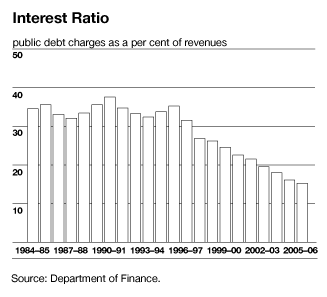
The Budgetary Balance and Financial Source/Requirement
The budgetary balance is the most comprehensive measure of the federal government’s fiscal results. It is presented on a full accrual basis of accounting, recording government liabilities when they are incurred, regardless of when the cash payment is made, and recording tax revenues when earned, regardless of when the cash is received.
In contrast, the financial source/requirement measures the difference between cash coming in to the Government and cash going out. It differs from the budgetary balance in that it includes cash transactions in loans, investments and advances, federal employees’ pension accounts, other specified purpose accounts, foreign exchange activities, and changes in other financial assets, liabilities and non-financial assets. These activities are included as part of non-budgetary transactions. The conversion from full accrual to cash accounting is also reflected in non-budgetary transactions.
Non-budgetary transactions in 2005–06 resulted in a net requirement of funds amounting to $6.4 billion, compared to a source of $5.1 billion in 2004–05. This turnaround largely reflects a change in the timing of the recognition and settlement of liabilities over the two years. In 2005–06, significant payments were made to settle liabilities recorded in 2004–05, including transfers under the Offshore Revenues Accords and the Wait Times Reduction Fund.
With a budgetary surplus of $13.2 billion and a net requirement from
non-budgetary transactions of $6.4 billion, there was a financial source of
$6.8
billion in 2005–06, up $0.2 billion from the $6.6-billion source posted in
2004–05 (Table 6).
Table 6
Budgetary Balance, Financial Source/Requirement and
Net Financing Activities
|
|
||
| 2004–05 | 2005–06 | |
|---|---|---|
|
|
||
| ($ billions) | ||
| Surplus for the year | 1.5 | 13.2 |
| Non-budgetary transactions | ||
| Pension and other accounts | ||
| Public sector pensions | 2.0 | 1.5 |
| Canada Pension Plan | -4.7 | -2.6 |
| Other | 1.6 | 1.3 |
|
|
||
| Total | -1.1 | 0.1 |
| Capital investing activities | -3.7 | -4.5 |
| Other investing activities | -4.4 | -3.7 |
| Other activities | ||
| Accounts payable, receivable, accruals and allowances | 7.2 | -2.3 |
| Foreign exchange activities | 3.4 | 0.0 |
| Amortization of tangible capital assets | 3.7 | 3.9 |
|
|
||
| Total other activities | 14.3 | 1.7 |
| Total non-budgetary transactions | 5.1 | -6.4 |
| Financial source/requirement | 6.6 | 6.8 |
| Net change in financing activities | ||
| Marketable bonds | -12.0 | -4.7 |
| Treasury bills | 13.8 | 4.4 |
| Canada Savings Bonds | -2.3 | -1.7 |
| Other | -6.1 | -4.3 |
|
|
||
| Total | -6.6 | -6.3 |
| Change in cash balances | 0.0 | 0.5 |
| Cash at end of year | 20.6 | 21.1 |
|
|
||
| Note: Numbers may not add due to rounding. | ||
With this financial source, the Government retired $6.3 billion of its unmatured debt and increased its cash balances by $0.5 billion. Cash balances at March 31, 2006, stood at $21.1 billion.
Federal Debt
Total liabilities consist of interest-bearing debt and accounts payable and accrued liabilities. Interest-bearing debt includes unmatured debt and liabilities for pension and other accounts. At March 31, 2006, interest-bearing debt amounted to $601.1 billion, down $6.2 billion from a year earlier (Table 7). Accounts payable and accrued liabilities amounted to $101.4 billion, up $3.7 billion from 2004–05. As a result, total liabilities at March 31, 2006 stood at $702.5 billion, down $2.5 billion from the previous year.
Table 7
Outstanding Debt at Year-End
|
|
||
| 2004–05 | 2005–06 | |
|---|---|---|
|
|
||
| ($ billions) | ||
| Liabilities | ||
| Accounts payable and accrued liabilities | 97.7 | 101.4 |
| Interest-bearing debt | ||
| Unmatured debt | 427.4 | 421.1 |
| Pension and other accounts | 179.8 | 179.9 |
|
|
||
| Total | 607.2 | 601.1 |
| Total liabilities | 705.0 | 702.5 |
| Financial assets | ||
| Cash and accounts receivable | 76.3 | 82.8 |
| Foreign exchange accounts | 40.9 | 40.8 |
| Loans, investments and advances | 38.2 | 41.9 |
|
|
||
| Total financial assets | 155.4 | 165.6 |
| Net debt | 549.6 | 536.9 |
| Non-financial assets | ||
| Tangible capital assets | 48.2 | 48.4 |
| Inventories | 5.5 | 5.9 |
| Prepaid expenses | 1.1 | 1.2 |
|
|
||
| Total non-financial assets | 54.9 | 55.4 |
| Federal debt (accumulated deficit) | 494.7 | 481.5 |
|
|
||
| Note: Numbers may not add due to rounding. | ||
Financial assets consist of cash and accounts receivable (including tax
receivables), foreign exchange accounts and loans, investments and advances.
Financial assets totalled $165.6 billion at March 31, 2006, up
$10.2 billion
from March 31, 2005. Increases were recorded in cash and accounts receivable (up
$6.5 billion) and in loans, investments and advances
(up $3.7 billion), while
net assets in foreign exchange accounts declined by $44 million. As a result,
net debt stood at $536.9 billion at March 31, 2006, down $12.6 billion from
March 31, 2005, and $72.1 billion below the peak of $609 billion at March 31,
1997. As a per cent of GDP, net debt dropped to 39.2 per cent in 2005–06, down
34.7 percentage points from its peak of 73.9 per cent in 1995–96. This is the
10th consecutive year in which the net debt-to-GDP ratio has declined.
Non-financial assets, consisting of tangible capital assets, inventories and prepaid expenses, amounted to $55.4 billion at March 31, 2006, up $0.6 billion from March 31, 2005.
With total liabilities of $702.5 billion, financial assets of $165.6 billion and non-financial assets of $55.4 billion, the federal debt (accumulated deficit) stood at $481.5 billion at March 31, 2006, down $13.2 billion from 2004–05 and $81.4 billion from its peak in 1996–97. The decline in federal debt between 2004–05 and 2005–06 was largely attributable to an increase in financial assets and a decrease in interest-bearing debt.
Both net debt and unmatured debt, expressed as a percentage of GDP, are now below 1983–84 levels.[3]
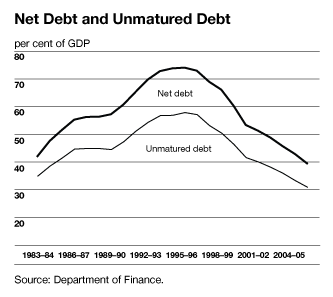
Comparison of Actual Budgetary Outcomes to Budget Estimates
This section compares the actual outcome for the major components of the budgetary balance for 2005–06 to the estimates presented in the May 2006 budget. The Government estimated a surplus of $8.0 billion for 2005–06 in the May 2006 budget. This amount was allocated to planned federal debt reduction. The final audited budgetary surplus for 2005–06 is $13.2 billion.
The increase in the 2005–06 surplus compared to the May 2006 budget was largely attributable to lower than expected program expenses, which were $3.9 billion lower than forecast in the budget. The estimate of other program expenses set out in the May 2006 budget was based on monthly financial information through February 2006. Traditionally, a significant amount of spending occurs in March. In addition, substantial adjustments are required in the end-of-year supplementary period to incorporate the cost of liabilities incurred during the fiscal year for which no payments were made, as well as new information based on tax assessments that are carried out in the March-to-May period. The difference between actual program expenses and the budget forecast was largely due to lower than expected departmental spending and accrual adjustments.
Within program expenses, elderly benefits were marginally lower than expected ($0.1 billion), while the Canada Child Tax Benefit was $0.1 billion higher than expected. Major transfers to other levels of government were $0.1 billion higher than expected.
Of the $3.9-billion difference between actual program expenses and the budget forecast, $1.4 billion was due to lower year-end spending by departments and Crown corporations. A further $1.5 billion was attributable to year-end accrual adjustments to reflect an increase in the estimated creditworthiness of debt owed to the Government, while the remaining $1.0 billion was attributable to year-end accrual adjustments for valuation allowances and provisions for liabilities, including liabilities for pensions and other employee future benefits.
Public debt charges were $52 million higher than estimated.
Budgetary revenues were $1.3 billion higher than projected in the budget, as lower than projected corporate income tax revenues were more than offset by other components of revenue that were higher than projected, particularly GST and non-tax revenues. Corporate income tax revenues were $2.8 billion lower than projected, as revenues rose significantly less than profits across a number of sectors. Non-tax revenues (excluding EI premium revenues) were $3.0 billion higher than projected in the budget, reflecting a $1.0-billion one-time increase in other revenues resulting from a change in the accounting treatment of the Government’s subscriptions in the IMF; stronger than expected revenues from Crown corporations; and higher than expected other non-tax revenues. Excise taxes and duties were $0.8 billion higher than projected, primarily reflecting stronger than expected growth in GST revenues.
Taken together, year-end accrual adjustments account for $3.5 billion of the $5.2-billion difference between the 2005–06 surplus estimated in the May 2006 budget and the final audited outcome.
Table 8
Comparison of Actual Outcomes to May 2006 Budget
|
|
|||
| Actual | 2006 budget | Difference | |
|---|---|---|---|
|
|
|||
| ($ billions) | |||
| Budgetary revenues | |||
| Personal income tax | 103.7 | 103.0 | 0.7 |
| Corporate income tax | 31.7 | 34.5 | -2.8 |
| Other income tax | 4.5 | 4.6 | -0.1 |
| Excise taxes and duties | 46.2 | 45.3 | 0.8 |
| Employment insurance premium revenues | 16.5 | 16.9 | -0.3 |
| Other revenues | 19.61 | 16.5 | 3.0 |
|
|
|||
| Total | 222.2 | 220.9 | 1.3 |
| Program expenses | |||
| Major transfers to persons | |||
| Elderly benefits | 29.0 | 29.1 | -0.1 |
| Employment insurance benefits | 14.4 | 14.4 | 0.0 |
| Canada Child Tax Benefit | 9.2 | 9.1 | 0.1 |
|
|
|||
| Total | 52.6 | 52.7 | -0.1 |
| Major transfers to other levels of government | |||
| Support for health and other social programs | 27.2 | 27.2 | 0.0 |
| Fiscal arrangements | 12.4 | 12.4 | 0.1 |
| Bill C-48 | 3.3 | 3.3 | 0.0 |
| Alternative Payments for Standing Programs | -2.7 | -2.7 | 0.0 |
| Canada's cities and communities | 0.6 | 0.6 | 0.0 |
|
|
|||
| Total | 40.8 | 40.8 | 0.1 |
| All other expenses | 81.8 | 85.7 | -3.9 |
|
|
|||
| Total | 175.2 | 179.2 | -3.9 |
| Public debt charges | 33.8 | 33.7 | 0.1 |
| Budgetary outcome/estimate | 13.2 | 8.0 | 5.2 |
|
|
|||
| 1 Includes revenues from Crown corporations,
foreign exchange revenues, including the $1.0-billion adjustment recorded
in 2005–06 to reflect a change in the Government’s accounting
treatment of Canada’s subscriptions in the IMF, and other program
revenues. Note: Numbers may not add due to rounding. |
|||
Notes:
1 Based on final results for New Brunswick, Ontario, Manitoba, Saskatchewan, Alberta and British Columbia and 2006 budget estimates for the remaining provinces. [Return]
2 Includes federal, provincial-territorial and local governments as well as the Canada Pension Plan and Quebec Pension Plan. [Return]
3 Due to a break in the series following the introduction of full accrual accounting, data from 1983–84 are not directly comparable with earlier years. [Return]
- Table of Contents - Next -
| Last Updated: 2006-09-26 | |||||